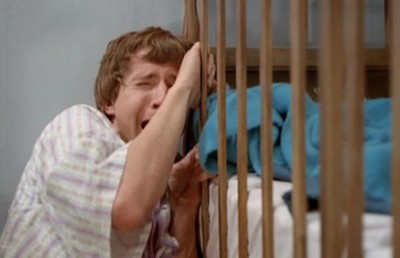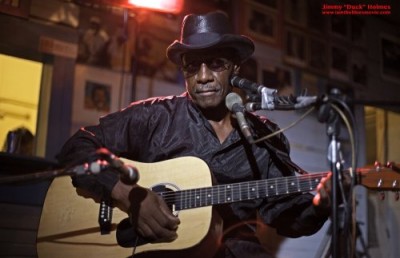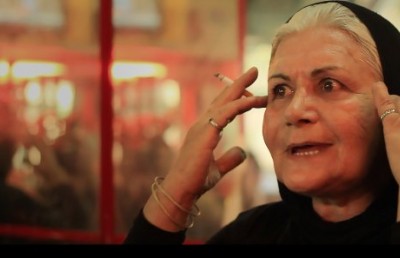As Far as the Eye Can See: An Interview with David Franklin
Texas on Screen
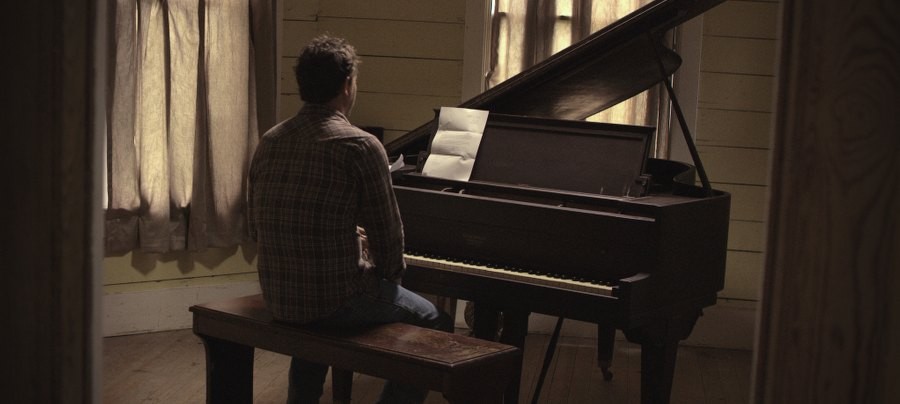
David Franklin is a former film professor and TV editor who has now directed his first feature film, the independently-produced As Far as the Eye Can See, which made its world premiere at the 2016 Montreal World Film Festival and is now making its way around the festival circuit. It is a sweet-natured tale, alternately thoughtful and funny, and with a nicely evocative sense of place. Franklin accompanied the film to Montreal and, after its successful screening before an enthusiastic audience, agreed to an e-mail interview. His answers, which shed light not only on his own film, but on the production process of a contemporary independent film, were received September 21, 2016.
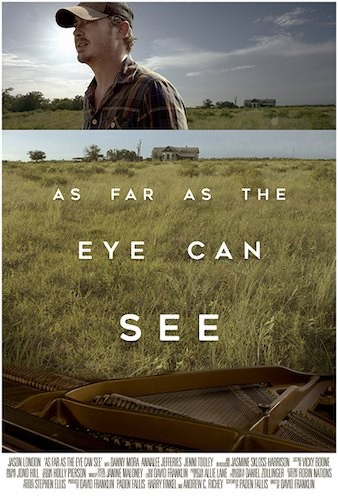
Offscreen: How did this film happen? Could you talk a bit about how this project developed?
David Franklin: In February 2013, Paden Fallis and I were both living in Brooklyn. And as I remember it, we were both also feeling a little run down by New York, and sort of frustrated with our careers. So one night we were hanging out and I said, “We should make a feature film.” To which Paden said, “Great. What’s it about?” And I remembered an idea he’d pitched me about his grandfather living on a farm in East Texas that he’d shelved. So I said, “Remember that film you were going to make about your grandfather? What if it wasn’t about your grandfather? What if it was about a guy like you? A guy who’s artistic, ambitious, but still living on a farm in Texas?” And Paden took that half-baked idea and turned it into a fully-fledged story about a pianist who had been a prodigy but was now spinning his wheels on his family’s farmland. He came back to me with the first 20 pages, and I said “Wow, this could be a movie!” By August, we had a full draft, and so we got a room of filmmaker friends together and an ensemble of twelve actors, and we read the whole script out loud. And the feedback from that reading was so encouraging that we decided to keep going. By fall 2014, we had gone through two more drafts and were feeling bullish enough to spend ten days in Texas, scouting locations and interviewing farmers and pianists. And because I’d gone to school at UT, I knew people in Austin who were able to meet with us on that trip and give us some nuts-and-bolts advice about how to actually shoot a movie there. And shortly after that a friend of ours said he’d give us the money to get it off the ground. And once that happened, well, that’s when we started actually making the film!
Offscreen: I was impressed by the physicality of the actors, particularly Jason London, who really gave a sense of awkwardness, that of a farmer who somehow has the ability to play the piano brilliantly. I was also struck by the shots of the three main characters sitting together in a room, which is very hard to do without seeming artificial. The way the actors stood or sat or related to each other’s presence came across as being very natural. Was this something you consciously aimed for? How much of it did the actors bring to the film, and how much is it direction? How did this collaboration work?
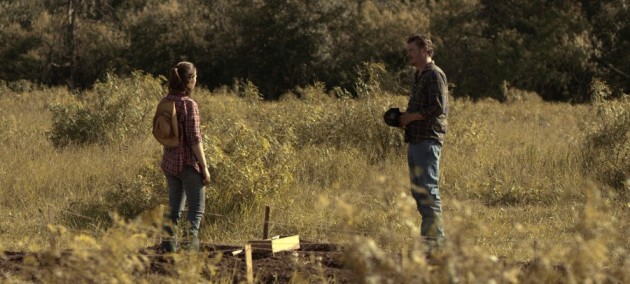
Jasmine and Jason in the garden
David Franklin: I think a big part of directing actors is done in casting, so a lot of the physicality and chemistry was there just by virtue of who we cast in the roles. But despite our low budget, I made sure that Jason London, Danny Mora, and Jasmine Skloss-Harrison had a chance to read through the script out loud, all together in the same room, before we started shooting. And as obvious as it may sound, that is not always possible to do. I think that “table read” helped get the actors in sync with each other, and may have helped to produce the effect you’re describing. In terms of their physicality, Jason, in particular, had a very clear sense of how his character should move. I think he was taking some cues from his own grandfather, who was from Oklahoma, which made good sense to me. Danny Mora, who plays Phillip, in addition to being a very experienced actor, is a standup comic. And he’s very light on his feet. So as a director, the notes I was giving were mostly just trying to help make sure that he and Jason wound up in the same movie, so to speak. In terms of the actors relating to each other in space, that was something I worked on with my cinematographer, Daniel Zollinger, to make sure that, as much as possible, the characters were sharing the screen space, rather than only speaking to one another only across cuts from static single shot to static single shot.
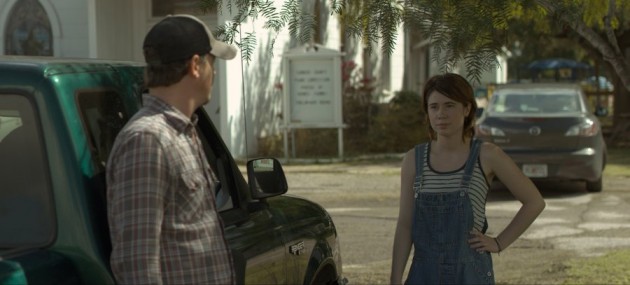
Jack and Alyssa at the church
Offscreen: I also liked the performance of the young actress Jasmine Skloss-Harrison. She has a nice pert quality, and is very effective in what could be a very tricky part, as one half of a non-sexualized cross-generational friendship. Could you talk a bit about the casting process in her case (what you were looking for, why you picked her, etc.), as well as her performance? Actually, can you talk about the casting process in general, since you have reasonably well-known performers (notably Jason London from that classic of Texas cinema, Dazed and Confused) mixing with less familiar faces.
David Franklin: We were lucky to have Vicky Boone, who has cast for Terrence Malick and Richard Linklater, as our casting director. So in addition to casting locally in Texas, she was able to put our script out to agencies in New York and Los Angeles, which is how Jason came to us. He read it without us even knowing he was interested, and then he lobbied hard for the part. But Vicky brought us a ton of possibilities, even for our supporting roles. For example, I think we saw at least ten auditions for the part of Jack’s estranged wife Claire, which wound up being played so well by Jenni Tooley (who also played Ethan Hawke’s second wife in Boyhood). So, for Alyssa, we saw a number of young women, some of whom were the same age as the character, and some of whom would have had to play younger than their actual age. I think the dynamic could have been very different if Alyssa had been played by an older actor.
As for why we cast Jasmine, she had an unaffected quality that is tough to find in young people. She always seems real, even when you talk to her between takes or away from set altogether. She’s just an authentic person, and she was smart like her character. So she could deliver these lines about cattle and historical markers and not sound like it was a put-on. As for downplaying the sexuality of the interaction, in addition to casting Jasmine, who was at the younger end of the spectrum, Holly Pierson, our costume designer, intentionally dressed Alyssa to deemphasize that side of her personality. And I think it also helped us that Jason has a daughter who is only a little older than Jasmine, and so his interaction with her on set was very fatherly to begin with, which then informed their chemistry during the actual scenes.
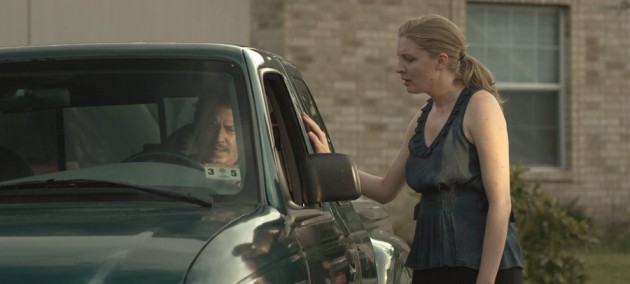
Jenni Tooley as Claire
Offscreen: Related to the last question, did you (and the screenwriter) consider making the relationship between Jack and Alyssa sexual? Did you ever think that a tortured sexual relationship between the two would be the kind of “subversive” and “edgy” fare that is catnip for festival programmers?
David Franklin: As Far As The Eye Can See is pretty much the antithesis of “subversive” or “edgy.” But, paradoxically, I think that was part of why I was passionate about making it. Having characters “break all the rules” has become something of a cliché in Independent Cinema, and so having characters who only break some of the rules, or maybe even only one of the rules, that’s tougher to make audiences care about. Which seemed like a real challenge to me. I’m a big fan of Milos Forman’s Loves of a Blonde, and our film also owes a debt to Tom McCarthy’s The Station Agent. And those are films in which the drama arises out of the choices the characters make rather than unbridled passions that compel them to some kind of forbidden love. So, did we consider that our festival chances would be enhanced if we went for more of a “Lolita” vibe? I think we joked about it. But it just didn’t seem like the kind of movie either Paden or I really wanted to make. And given that Jasmine’s performance (and the relationship between Jack and Alyssa) seems to be one of the most consistently praised elements of the finished film, I feel like we made the right choice.
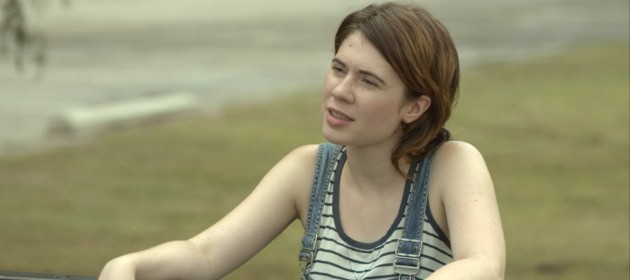
Alyssa at the back of the truck
Offscreen: Could you also talk about the pacing of the film, which is deliberate, and punctuated by landscape shots and lots of shots of people driving? It seemed to me both the pace and use of landscape had thematic importance, as well as being useful in creating a specific small town atmosphere. In fact, the landscape seemed to be at least as important a character as Jack himself. Do you agree? There is also a wonderful shot of clouds that resemble weird ice cream cones. Does Texas really look like that? Could you talk about the contribution of your DP?
David Franklin: I think “deliberate” is a nice word to describe the pace of the film. It’s definitely slower than your average Hollywood movie. As for the driving shots, no one in this film has a cell phone, so every time they want to talk to each other they have to drive to the other person to have the conversation in person. When we were scouting for the film in the fall of 2014 I was struck by how far away from each other people in Texas live. Even people who technically live in the same town might live five or six miles from each other’s houses. And yet they think nothing of jumping in their truck and driving over there just to say “Hi.” So I think the landscape is a major character, because it’s a major reality in the lives of the rest of the characters. But it also has a metaphorical function: the central dilemma that Jack faces in the movie is what to do now that his life hasn’t turned out the way he thought it would. And so the horizon is always there, with his possible future just on the other side of it. But there’s also a literal, limiting quality to the landscape as well, since Jack has gotten stuck on his family’s farm, and everywhere he looks, there he still is.
And to answer your question, yes, Texas really looks like this. I think it’s credit to Daniel Zollinger, our cinematographer, that we managed to capture it. That shot you describe of the clouds is something he picked up while we were shooting another one of those driving shots. And we liked it so much that it’s on the splash page of our website Daniel has a great eye, and he was always willing to go the extra mile, grab one more shot if something caught my attention, or if I thought we might be able to use it. I think a lot of what he was doing in terms of lighting and framing was hard to put into words, so I was just glad that we were in sync visually, so once we discussed where to put the camera, I could be confident that the shot was going to look good once he had it set up.
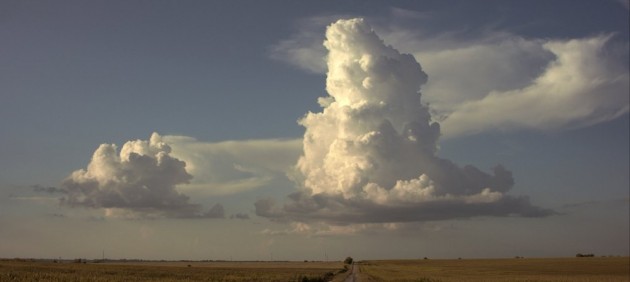
Ice cream clouds
Offscreen: Although the film has a nice low-key realism, there also seem to be elements of fantasy. For example, the shot of a house being towed away is shot in a slightly artificial way to make it seem vaguely surreal. There is also, of course, the business with the pie. What do you think these elements that move away from straightforward realism bring to the story?
David Franklin: I believe that cinema is essentially unrealistic. In narrative filmmaking, you’re always pretending as you film and asking the audience to play along. Even in a documentary, a static shot of a real event that unfolds in “real time” from a fixed camera position is still obscuring everything that’s off-screen. So unreality is inherent to the medium. My feeling is as long as you have created characters that the audience can invest in, I’m not sure of the utility of making everything in the film adhere to the rules by which we live our everyday lives. To me “realism” just means taking elements off the table that could be useful to me as a filmmaker and storyteller. So, yes, there are a number of surreal elements in the film, the pie being the most conspicuous. But I think I already mentioned that no one in this movie has a phone. Or a computer. Which is obviously unrealistic in the extreme. And the likelihood that the neighbor’s house would be towed away like that, rather than just being sold and left in place, is very low. But to me, the irrational, improbable elements allow the narrative logic to become more dream-like, which then lets us get at some of the emotional truths of the story in a way that wouldn’t be possible if we were constrained by what is “real” and what is not. I guess what I’m saying is that I’ll happily sacrifice realism for emotional resonance any day of the week.

House on trailer
Offscreen: It seems to me I am increasingly seeing in the media sharply caricatured images of red and blue America, and this film completely subverts this. For example, instead of having your small town Texans listening exclusively to country music, you show a community enthralled by a classical music competition. Which, in a region where Van Cliburn seems to have almost mythical status, makes a lot of sense. Was this intentional?
David Franklin: We were conscious from the beginning that making a film about classical music in a small Texas town was going to subvert conventional storylines about rural life in America, although I think it would happen anyway if you just drill down far enough into the lives of the characters. Our screenwriter, Paden Fallis, grew up hearing his mother, who was raised on a farm, tell stories about the classical pianist Van Cliburn, who is very much a revered figure in a lot of North East Texas. And when we were scouting, we wound up in a place called Festival Hill, where they have a 3000 seat Bavarian-style concert hall in a town with a population of 98 people. So there’s a strong tradition of classical music in Texas that goes beyond just Van Cliburn and the competition that bears his name. So yes, I think what you’re describing is very close to what we were hoping to achieve.
Offscreen: The script has a nicely detailed portrait of small town life, both in its idiosyncrasies (piano and pie competitions, secret histories of Mexican migration, attachment to the land in the face of agribusiness corporations) as well as its dead end nature for those whose ambition or imagination stretches further than the eye can see. Could you talk about the screenwriter’s attitude toward small town life as well as what you had to do in terms of scouting locations and/or building sets to create your fictional small town?
David Franklin: Paden grew up in Fort Worth, but his mother’s family was from a town called Windom, which is up near the Oklahoma border. So when we were scouting, we visited Windom and took a bunch of photos, which we then used as reference when we were actually shooting the movie so that we could choose locations that all seemed to “fit” both with each other, and also with the geography of the town he had in mind as he was writing. I don’t want to speak for him, but I don’t think it’s too much of a stretch to say that Paden, who is an actor who left Texas to move to New York, is very aware of the limitations that these small towns place on people who dream of doing more than raising cattle or working at the grain elevator. But I think it’s clear from the movie that he also has a lot of affection for the townspeople and the way they live. And throughout the film, the character of Alyssa is really a booster for the town and its continued relevance (and its potentially vibrant future).
In terms of creating our fictional small town of Paget, we didn’t have the budget to build sets. But our production designer Allie Lane and art director D. R. Garrett were able to dress an empty stretch of downtown Elgin, Texas to stand in for the main street of Paget. And I think those early establishing shots really helped to stitch together the variety of other locations that became our town. In reality, we were filming over an arc of about sixty miles from Niederwald, TX in the south to Taylor, TX in the north. The limitation was that we had to be within a half-hour drive of Austin so that our crew could go home at the end of the day and get a decent night’s sleep.
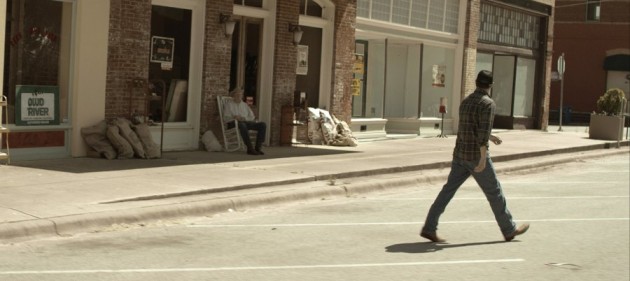
Main Street, Paget. Shot on location in Elgin, TX
Offscreen: There is an interesting tradition of Texas filmmaking, from the films of Richard Linklater to older films like The Last Picture Show and Lone Star. Were you influenced by any of them? Would you situate this film in a tradition of Texas filmmaking, or is that too much of a stretch? [The Town That Dreaded Sundown, 1976, is another film that makes interesting use of its Texas locale, ed.]
David Franklin: There is indeed a great tradition of Texas filmmaking, though the one you left out that was probably the most relevant to us was Tender Mercies, with Robert Duvall and Tess Harper, based on a script by Horton Foote. Also, Wim Wenders’ Paris,Texas was an influence visually, although the movie itself has nothing to do with the real Paris, Texas, which is where we stayed when we were scouting Windom. Obviously the small town in The Last Picture Show has some elements in common with As Far As The Eye Can See. But so does the town in Hud. In terms of a direct influence, I would say I was thinking more of Linklater’s Bernie as we were actually shooting. The monologue that Sonny Carl Davis gives about the “Five states of Texas” at the beginning of that movie is one of my favorite film moments ever. And I love how Linklater makes all the inhabitants of Carthage larger than life even in the shortest scenes. We definitely tried to give our supporting players similarly big personalities.
“Five states of Texas” monologue from Bernie:
Offscreen: Without going into specific numbers, could you talk about how you raised the money for the film? And, following from that, how does an independent film of any kind make money these days? How do you even get your film in front of audiences? Did you have a strategy for this from the start or are you just winging it?
David Franklin: We raised the money from investors, who turned out to be our friends and family members. But we had been developing the film for two years (and had traveled to Texas to scout for two weeks on our own funds) before any of that money began to fall into place. So I really am a believer in the “if you build it, they will come” model of artistic creation. We also ran a successful Kickstarter to raise post-production funds once we had a cut of the movie, so that was helpful as well.
In terms of distribution, we’re kind of taking the same “if you build it they will come” approach. We’re trying to use festivals to get press, use press to build awareness, and then either a distributor will come calling or they won’t. But we’ve certainly been thinking about the question of how to get it in front of an audience since we first started making the movie. And actually, the box office successes of Bernie and Mud were major encouragements to us, because they demonstrated an audience demand for films about the so-called “flyover” states between America’s coasts. So despite our current low profile, hopefully the old William Goldman adage that “nobody knows anything” still applies and the fact that the solution isn’t obvious won’t mean there isn’t one. I’m still very optimistic that we will figure out how to make As Far As The Eye Can See a success. But it’s definitely a tough slog these days trying to address the financial side of the equation.
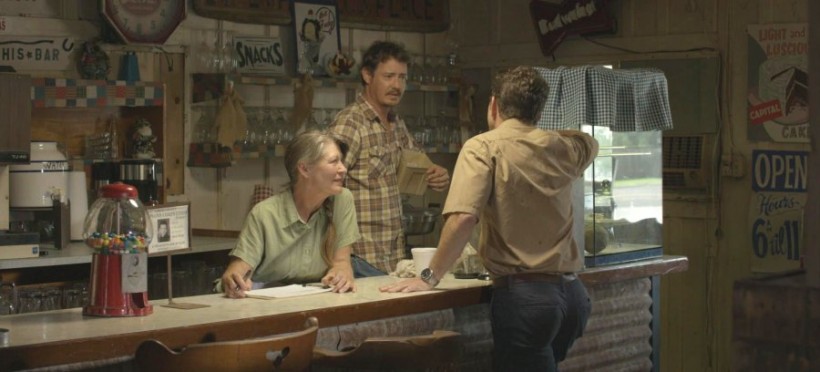
Annalee Jefferies as Elyn
Offscreen: Could you talk more generally about films and filmmakers who have influenced you, and if you are conscious of examples of these influences turning up in As Far as the Eye Can See?
David Franklin: I’m a product of American film school, so of course I love the films I saw there, from John Ford to Maya Deren to Andrei Tarkovsky. But I’m also a big fan of Emeric Pressburger and Michael Powell — The Life and Death of Colonel Blimp was an important film for me as a teenager. I also loved Bill Forsyth’s early films Gregory’s Girl and Local Hero, the latter of which I made Paden watch while we were working on the script for As Far As The Eye Can See. And for directors of performances, I’m a huge fan of Mike Leigh in Britain and Carl Franklin (no relation) in Hollywood. I also like a more aesthetically challenging strain of films, like Clair Denis’s Beau Travail and Krystof Kieslowski’s Double Life of Veronique. And I mentioned Milos Forman earlier in one of my other answers, but I’m a Czech new wave fan in general. Also, David Lynch has had a big impact on me as a filmmaker, though people keep telling me As Far As The Eye Can See reminds them of The Straight Story, which is the one film of his I’ve never seen. Other favorite filmmakers are Charles Burnett, Pedro Almodovar, Kathryn Bigelow, the Dardenne Brothers, and Steven Soderbergh. As to how any of them informed As Far As The Eye Can See, I can think of specific shots here and there that have antecedents in other films, but mostly I think my voracious appetite for films when I was young functioned to expand my filmic vocabulary. And then the choices I make on set mostly feel like an instinctive reaction to the circumstance at hand.
Offscreen: Finally, could you talk about your background and why you chose this material (or it chose you?) to make your debut as director?
David Franklin: When I was an undergraduate at the University of Illinois at Champaign-Urbana, I wrote for the Daily Illini, and they would reimburse me for any film I reviewed. So I would write capsule reviews of every film playing in our local area that week so that I could see them for free. So I literally saw every film that was released commercially in central Illinois during that time. And I saw a lot of great films: Mystery Train, Terminator 2, and To Sleep With Anger, just to name three. But there were also some truly terrible films, like Loose Cannons, with Gene Hackman and Dan Ackroyd. Or Not Without My Daughter, with Sally Field. Yikes! So those years really shaped my sense of what made a good film good, and conversely, what kinds of films made me want to tunnel out of the theater through the floor to escape. And I think those instincts were refined by spending eight years working with college students on their short film projects, and then even more by the ten years I spent as a television editor at CBS. In 2011, I took a leave of absence to edit a feature film called Los Condenados, directed by my friend Roberto Buso-Garcia. And I found myself both inspired and jealous of Roberto. He had quit his job at HBO to direct the film, and I asked myself why I hadn’t done the same. When I left CBS in 2014 to pursue making As Far As The Eye Can See, I think I was following his lead. And I did it for this particular project because the story really spoke to me. Like Jack, I had a great start in life. I was the youngest member of my graduate class at UT (I started there when I was 20 years old). And then I got a tenure-track teaching job when I was 23. So I was doing all right. And then my 20s and 30s were a kind of slow unraveling of all that ambition and drive, until in my early forties, I was doing a job where most of my colleagues were 20 years my senior, and where I had no hope of advancement. And, gratifyingly, in the process of making As Far As The Eye Can See, I’ve turned my life around in ways that parallel the plot quite nicely.
Hopefully this all makes some kind of sense, and thank you so much for giving me the opportunity to speak to Offscreen.
Official trailer for As Far as the Eye Can See: https://vimeo.com/147205302

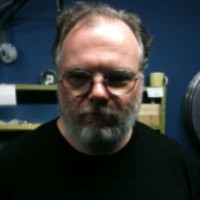

_400_258_90_s_c1.jpg)
